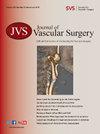医生改良内移植物十年。
IF 3.9
2区 医学
Q1 PERIPHERAL VASCULAR DISEASE
引用次数: 0
摘要
目的:医生改良内植物(PMEGs)将血管内腹主动脉修复的范围扩大到了肾下主动脉以外。手术风险过高和患有内脏段疾病的患者通常都适合接受这种介入治疗,从而降低了传统开放式修复术的发病率和死亡率。在此,我们介绍了一家大容量主动脉中心的 PMEG 经验:方法:我们研究了 2012-2023 年在本机构实施的所有 PMEG。其中包括提交给 FDA 以支持 IDE 试验的病例,以及随后批准的 IDE 试验中的病例。在这 11 年间,我们评估了手术特征和围手术期疗效随时间推移而发生的变化。此外,我们还将 PMEG 案例的疗效与 Zenith Fenestrated (ZFEN) 移植物(由获得 PMEG IDE 的外科医生完成)的疗效进行了比较,Zenith Fenestrated (ZFEN) 移植物是一种用于内脏下段动脉瘤的替代设备。我们在此评估了手术特点、围手术期结果、5 年存活率和再介入率:结果:在评估 PMEG 手术特征随时间推移的变化时,我们发现透视时间有缩短的趋势,I 型和 III 型内漏的比例也有下降的趋势(所有 pConclusions):在我们使用 PMEG 超过 10 年的经验中,我们注意到手术效果有所改善,这可能归功于技术的进步和医生经验的增加。此外,我们还发现,与 ZFEN 相比,尽管 PMEG 是一种更复杂的修复方法,能够治疗更大段的主动脉,但 PMEG 仍然表现出色。PMEG 对于全面治疗患有复杂主动脉疾病的血管患者至关重要。随着手术技术的进一步发展,我们预计这种介入方法的使用率会越来越高。本文章由计算机程序翻译,如有差异,请以英文原文为准。
Ten years of physician-modified endografts
Objectives
Physician-modified endografts (PMEGs) have expanded the scope of endovascular abdominal aortic repair beyond the infrarenal aorta. Patients with prohibitively high surgical risk and visceral segment disease are often candidates for this intervention, which mitigates much of the morbidity and mortality associated with conventional open repair. Here we present the institutional PMEG experience of a high-volume aortic center.
Methods
We studied all PMEGs performed at our institution from 2012 to 2023. We included cases that were submitted to the US Food sand Drug Administration in support of an investigational device exemption (IDE) trial, as well as those in the subsequently approved IDE trial. Over this 11-year period, we assessed the changes in operative characteristics and perioperative outcomes over time. Additionally, we compared the outcomes from PMEG cases to those of Zenith fenestrated (ZFEN) grafts (done by the surgeon with the PMEG IDE), an alternative device used for aneurysms involving the lower visceral segment. Here we assessed operative characteristics, perioperative outcomes, and 5-year survival and reintervention rates.
Results
When assessing the change over time for PMEG operative characteristics, we found a trend toward decreased fluoroscopy time and decreased proportions of completion type I and type III endoleaks (all P < .05). Perioperative outcomes have remained stable over this period, with an overall perioperative mortality rate of 4.9% (noting that this registry also includes cases that were urgent and emergent). Despite the increased complexity of PMEGs relative to ZFENs, we found comparable perioperative outcomes with regard to mortality (4.9% vs 4.3%; P = .86), permanent spinal cord ischemia (1.1% vs 0%; P = .38), postoperative myocardial infarction (4.3% vs 2.9%; P = .60), postoperative respiratory failure (7.1% vs 4.3%; P = .43), and new dialysis use (2.2% vs 4.3%; P = .35). Additionally, 5-year survival (PMEG 54% vs ZFEN 65%; P = .15) and freedom from reintervention (63% vs 74%; P = .07) were similar between these cohorts.
Conclusions
Throughout our >10-year experience with PMEGs, we have noted improvements in operative outcomes, which can likely be attributed to technological advances and increased physician experience. Additionally, we have found that PMEGs perform well when compared with ZFENs, despite being a more complicated repair that is able to treat a larger segment of the aorta. PMEGs are crucial for the comprehensive care of vascular patients with complex aortic disease. As further operative advancements are made, we only expect the use of this intervention to increase.
求助全文
通过发布文献求助,成功后即可免费获取论文全文。
去求助
来源期刊
CiteScore
7.70
自引率
18.60%
发文量
1469
审稿时长
54 days
期刊介绍:
Journal of Vascular Surgery ® aims to be the premier international journal of medical, endovascular and surgical care of vascular diseases. It is dedicated to the science and art of vascular surgery and aims to improve the management of patients with vascular diseases by publishing relevant papers that report important medical advances, test new hypotheses, and address current controversies. To acheive this goal, the Journal will publish original clinical and laboratory studies, and reports and papers that comment on the social, economic, ethical, legal, and political factors, which relate to these aims. As the official publication of The Society for Vascular Surgery, the Journal will publish, after peer review, selected papers presented at the annual meeting of this organization and affiliated vascular societies, as well as original articles from members and non-members.

 求助内容:
求助内容: 应助结果提醒方式:
应助结果提醒方式:


